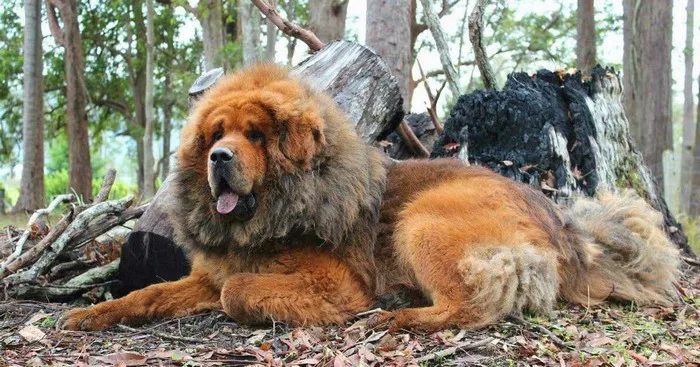The allure of Tibetan Mastiffs is undeniable, their majestic presence and formidable stature making them a coveted breed among dog enthusiasts worldwide. However, for those venturing into the world of Tibetan Mastiff ownership, the staggering price tags associated with these magnificent canines can be perplexing. In this article, we delve into the intricate factors that contribute to the hefty price of Tibetan Mastiffs, shedding light on the mystique surrounding their exclusivity and high cost.
Historical Significance and Rarity
Tibetan Mastiffs, with roots dating back over a thousand years, carry a rich historical significance. Originally bred to guard livestock in the Himalayas, their rarity stems from their unique bloodline and ancient lineage. The preservation of these pedigrees has become a meticulous art, resulting in limited availability and subsequently driving up their market value.
Distinctive Appearance and Characteristics
One of the primary reasons Tibetan Mastiffs are so expensive lies in their distinctive appearance and exceptional characteristics. Their lion-like mane, muscular build, and assertive demeanor contribute to their regal and imposing presence. Breeders invest significant time and resources in maintaining these distinct features, ensuring that each Tibetan Mastiff adheres to the breed standard, a process that demands meticulous attention to detail.
Health Screening and Genetic Purity
Responsible breeders prioritize the health and genetic purity of Tibetan Mastiffs, conducting rigorous health screenings to eliminate potential hereditary issues. This dedication to the well-being of the breed requires substantial investments in veterinary care, genetic testing, and maintaining optimal living conditions. The meticulous selection of breeding pairs further ensures that the lineage remains robust and free from common health concerns.
Specialized Care and Dietary Needs
Tibetan Mastiffs are known for their unique dietary needs and specific care requirements. Their large size and robust constitution necessitate a diet rich in high-quality ingredients to support their overall health. Specialized care, including spacious living conditions and regular grooming, adds to the overall cost of raising and breeding Tibetan Mastiffs, further justifying their elevated price point.
See Also: How Big is a Tibetan Mastiff?
Long Gestation Period and Limited Litter Size
The reproductive cycle of Tibetan Mastiffs is a lengthy process, with a relatively long gestation period compared to other dog breeds. Additionally, these majestic canines tend to have smaller litter sizes, further limiting the availability of puppies. Breeders, cognizant of these factors, must invest considerable time and resources in the breeding process, resulting in higher costs that are reflected in the market price of Tibetan Mastiffs.
Temperament and Training
The distinctive temperament of Tibetan Mastiffs adds to their desirability, particularly as guardians and companions. However, cultivating and maintaining their balanced temperament requires extensive training and socialization efforts. Experienced breeders invest time in early socialization and behavioral training, ensuring that each Tibetan Mastiff is not only physically robust but also possesses the desirable temperament traits associated with the breed.
Global Demand and Limited Breeder Network
As the global interest in Tibetan Mastiffs continues to rise, the demand for these majestic dogs has surpassed the limited supply. The breed’s exclusivity is amplified by a comparatively small network of responsible breeders who adhere to strict standards. The combination of heightened demand and a restricted breeder network results in an imbalance that naturally escalates the market value of Tibetan Mastiffs.
Importation Costs and Quarantine Regulations
For enthusiasts seeking top-quality Tibetan Mastiffs, the option of importing these dogs from their native regions may arise. However, the process of importation involves significant costs, including transportation, quarantine regulations, and compliance with international breeding standards. These added expenses contribute to the overall cost of acquiring a Tibetan Mastiff, particularly if one is seeking a specific bloodline or pedigree.
Show Quality and Champion Bloodlines
Tibetan Mastiffs with show-quality attributes and champion bloodlines command a premium price. The meticulous breeding and exhibition processes involved in producing show-quality dogs require additional investments in time, resources, and participation in competitive events. As a result, enthusiasts willing to invest in a Tibetan Mastiff with a proven lineage and potential for success in dog shows can expect a higher price tag.
Ongoing Support and Breeder Reputation
Responsible breeders of Tibetan Mastiffs prioritize the well-being of their dogs even after they leave the breeding facility. This commitment includes ongoing support for new owners, guidance on proper care, and assistance with any challenges that may arise. The reputation of the breeder plays a crucial role in the overall cost, as reputable breeders often have a waiting list of potential buyers willing to pay a premium for the assurance of a healthy, well-adjusted Tibetan Mastiff.
Conclusion
In conclusion, the high cost of Tibetan Mastiffs is a multifaceted outcome of historical significance, rarity, distinctive characteristics, health considerations, specialized care, and global demand. The meticulous efforts invested by responsible breeders to maintain the breed’s integrity, coupled with the limited availability of these majestic dogs, contribute to their exclusivity and, consequently, their premium price. For those captivated by the allure of Tibetan Mastiffs, understanding the intricacies behind their cost is essential in making an informed decision when entering the world of ownership for these magnificent canines.
Related Topics:
How Much is a Tibetan Mastiff?
Is the mastiff a good dog? Introduction to the Mastiff
How are mastiffs trained
























